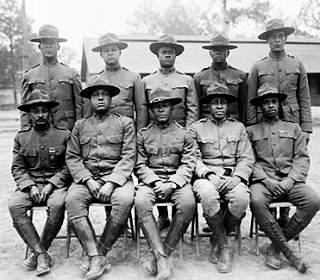
Men of the 24th Infantry Regiment
On April 8th, 1916 elements of the 24th United States Infantry Regiment visited the border town of Del Rio, Texas. This all-black unit, veterans of the Spanish-American War and service in the Philippines, was among the soldiers mobilizing for John Pershing's Punitive Expedition against Pancho Villa. Several members of the regiment attempted to visit the local brothel during their leave. The proprietor turned them away, refusing to allow white women, even prostitutes, to be "defiled" by black men, even soldiers.The men of the 24th, proud of their military record and instinctively resentful of racism, returned that evening determined to force their way into the brothel. Denied again, they subjected the building and its patrons to a fusillade of rocks, garbage and rifle fire. A mixed posse of local deputies and Texas Rangers arrived and attempted to disperse the soldiers; a scuffle arose, the details of which remain disputed. The most dramatic result, however, wasn't: Ranger W.L. Barlor drew his weapon and shot Private John Wade in the neck, killing him.
This incident epitomizes the sorry state of American race relations on the eve of World War I. Each side had their worst fears confirmed in Del Rio: black men, infuriated by racism both systemic and casual, culminating in a cold-blooded murder by law enforcement; white men, terrified by black men carrying arms and intent on sexual intercourse. That the violence wasn't completely one-sided, at a time when whites lynched dozens of blacks every year, was the only surprise. Yet it was merely an overture to a far uglier incident involving the 24th a year later.
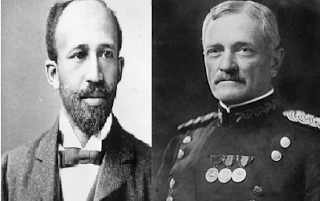
Activist and General: W.E.B. DuBois (left) and John Pershing
War came in April 1917, and African-Americans rallied to the colors; over 350,000 men enlisted. Black leaders encouraged this flood tide of patriotism, with W.E.B. DuBois insisting "if this is our country, this is our war" and the Reverend Adam Clayton Powell, Sr. arguing that military service "constitutes...the strongest argument and the noblest appeal for political and economic rights which colored men could present." General Pershing, whose nickname "Black Jack" stemmed from his time commanding the 10th Cavalry, promised that "I cannot and will not discriminate against these soldiers."Initially, DuBois and Powell seemed prescient. Americans, black and white, thrilled to the exploits of the 369th Infantry, the "Harlem Hellfighters" which saw heavy action on the Western Front. In May 1918, Private Henry Johnson, formerly an Albany porter, fended off two dozen German soldiers with fists, an unloaded rifle and a bolo knife to rescue Private Needham Roberts, shrugging off 21 wounds in the process. Johnson, who won a Croix de Guerre (and, 98 years later, a posthumous Medal of Honor) for his courage, became renowned as the "Black Death."
But Johnson's heroism and his regiment's sacrifice (40 percent casualties through six months of combat) didn't dissipate military racism. Despite Pershing's personal color-blindness, his subordinates humiliated black troops and their white officers, assigning them to menial tasks and hard labor rather than front-line duty. The Hellfighters were more impressed by French officers and soldiers, who treated them with a relative lack of prejudice. The Cleveland Gazette observed that "the Afro-American soldier overseas certainly had a hard time of it, with the Germans in front of him and prejudiced Southerners on all three of his other sides."
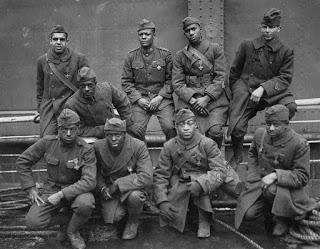
The Harlem Hellfighters
Things were even worse at home, where traditional Jim Crow laws rankled in the South and tensions spurred by black migration simmered in the North. Eighty-six black men were lynched in America during 1917 and 1918, along with occasional race riots. The most extreme occurred in East St. Louis, Illinois on July 2nd, 1917, where confrontations between black and white gangs triggered a savage pogrom that claimed up to 150 black lives. One newspaper ran a cartoon asked President Woodrow Wilson, whose administration had segregated the Federal government while demanding liberty abroad, whether he might "Make America Safe for Democracy" before liberating Europe.This was the atmosphere in which the 3rd Battalion, 24th Infantry arrived in Houston, Texas on July 28th, just three-and-a-half weeks after East St. Louis. They encamped at Camp Logan, three miles outside of town. Their commander, Colonel William Newman, had been present at Del Rio the previous year and knew that "it angered Texans to see colored men in the uniform of a soldier." And Sergeant Cecil Green commented that the 24th "expected trouble from mobs" the moment they arrived in town.
Local authorities and military officials tried to defuse tensions. Houston newspapers ran laudatory articles assuring citizens that they had nothing to fear from the 24th. "Discipline among the Negro regiments is almost perfect," crowed the Post, while the Chronicle emphasized their recent service with Pershing in Mexico. Incidents flared almost immediately, however, when black soldiers in town disobeyed segregation rules. Almost immediately, a group of soldiers, angered at being denied seating in a trolley, commandeered a nearby car and threatened violence if they were removed.
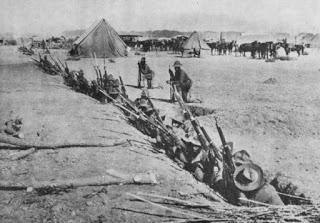
The 24th during service in Mexico
Colonel Newman attempted to control his men by limiting their visits to Houston, forcing his military police to carry nightsticks instead of sidearms when patrolling black neighborhoods and limiting sentries to a single five round rifle clip. Which didn't halt the boorish conduct of white construction workers helping to build Camp Logan; they peppered the soldiers with racial epithets and threats, causing resentment and confrontations. On one occasion, a sentry angrily confronted a foul-mouthed paymaster: "I want you to understand that we ain't no niggers. I am not a nigger."Despite such assertiveness, incidents continued to escalate. On August 18th, a white laborer at Camp Logan murdered a black colleague, leading to a scuffle among the construction workers that spilled into the 24th. In Houston itself, soldiers from the 24th butted heads with troops from the 5th Infantry, an Illinois National Guard unit, who traded racist insults and violent challenges in the street. One of the latter, in his cups, blurted to an officer from the 24th that "in Texas it costs 25 dollars to kill a buzzard and 5 dollars to kill a nigger."
But it was Houston's police who caused the worst problems. Despite Police Chief Clarence Brock's promises to cooperate with Newman, his officers began targeting the soldiers for abuse or assault. On the 18th, two soldiers protesting the arrest of a black vagrant were pistol-whipped and hauled into jail. The same fate awaited another soldier a few days later, for sitting in a whites-only rail car. In the weeks before the riot, at least a dozen soldiers were arrested for assorted charges. Newman's peacemaking efforts came to naught; he was reassigned on August 20th and replaced with Major Kneeland Snow.
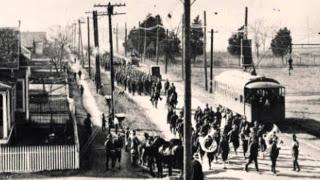
Houston in 1917
The explosion finally came on August 23rd, a day on which the temperature reached a staggering 102 degrees. On this date, two mounted policemen, Rufus Daniels and Lee Sparks, arrested another black soldier, prompting Corporal Charles W. Baltimore to intervene. Baltimore asked the policemen "what had been the trouble with the soldier they had just arrested." This infuriated the two officers, especially Sparks, whom an historian called "one of the most vociferous racists on the police force."Sparks struck Baltimore with his pistol, asking the startled soldier "Don't you like it?" as he beat him. Baltimore, unarmed, attempted to flee his tormentor; Sparks responded by firing several shots. He pursued Baltimore into a nearby house, dragged him back into the street and pistol-whipped him, before dragging him into custody. Hearing of the incident, Major Snow marched down to the police station and demanded Baltimore's release from custody. Brock, shocked (or affecting shock) by Sparks' behavior, chewed out the patrolman and suspended him.
Once word of Baltimore's beating reached Camp Logan, the men of the 24th decided they had enough. Sergeant Vida Henry warned Snow that "I think we are going to have trouble tonight," while a private openly threatened to "shoot every white face [I] saw." Snow cancelled a planned event with Houston's black community and demanded that his men turn in their arms. About thirty men refused and confronted the Major with loaded rifles. Snow, a new commander completely out of his depth, recalled that they "paid no attention to me whatsoever."
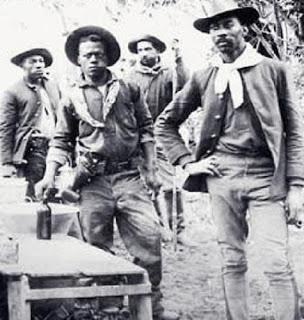
Then Sergeant Henry, who had earlier warned Snow of the burgeoning trouble, took command of Company I and ordered them into line. "Stick by your own race," he exhorted his men, yelling them to forget the war with Germany and "get to work right here." Most men of the battalion, stunned by this call to violence, refused to follow him. But neither did they try and stop Henry when, at around nine o'clock, he led 110 men from Companies I and M on a vengeful march into Houston.
The soldiers marched into town, first moving through the San Felipe neighborhood in hopes of killing Patrolmen Sparks and Daniels. Once they reached Washington Street, the soldiers found several armed police awaiting them, including both of their targets. The police attempted to disperse Henry's men, who responded by opening fire. In this exchange, Patrolman Daniels and three other officers were killed, three more injured, and the rest scattered.
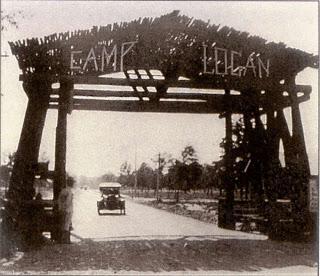
The mutineers inflicted violence and sewed chaos, yet as they spread out their numbers and force dissipated; many started drifting back to Camp Logan, or else to Houston's black neighborhoods to hide. Sergeant Henry attempted to persuade his men to march on the police station, but they hesitated. As the soldiers argued, a car carrying several Guardsmen from the 5th Infantry sped towards them. Henry and his entourage opened fire, killing two white soldiers and wounding several others.
This encounter finally broke the mutineers' spirit; the men decided to break off their rampage and return to Camp Logan. Sergeant Henry, horrified at having killed fellow servicemen, refused to join them. Instead he wished his colleagues luck, shaking their hands and watching them walk back to camp. Police found Henry dead in the streets the next day, having evidently taken his own life.
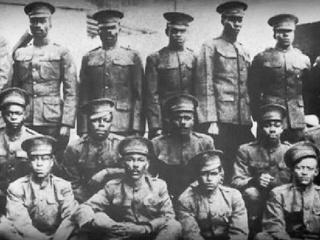
In all, the riot claimed sixteen lives, twelve civilians (including police) and four white soldiers, with dozens of additional injuries. The War Department instituted three courts martial against soldiers from the 24th, convicting 110 men and executing 19. Thirteen of these were executed near Camp Travis at San Antonio, their executions taking place at a gallows hastily constructed overnight. On December 10th, they were hanged at first light, with only prison guards and the local Sheriff as witnesses.
Responses to the riot and trials were deeply polarized, ranging from horror and disgust to near-praise depending on the race and political views of the observer. Houston papers offered predictable sentiments, like a Chronicle headline reading, "Murderous Riot Replaces Negro Watermelon Party." While The Outlook proclaimed it "one of the most disgraceful mutinies of American troops in our history," black publications like The Crisis, the NAACP's house magazine, proclaimed the mutineers "martyrs for democracy." The New York Age thundered that "at some time and some way full justice will be done."
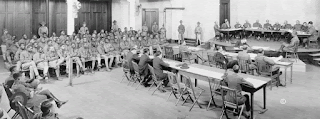
The 24th on trial
Eventually, pressure from the NAACP, the press and his progressive allies reached President Wilson's ears. Despite his prejudices, Wilson intervened in August 1918, commuting the sentences of ten condemned soldiers to life imprisonment. This infuriated many conservative Democrats, including Senator James K. Vardman of Mississippi, who commented that "whites are opposed to putting arrogant, strutting representatives of the black soldiery in every community." For blacks, however deplorable the deaths of white civilians, it previewed a doctrine championed by Malcolm X, Huey Newton and others a half-century later: armed self-defense.The experiences of East St. Louis and Houston, along with the wartime heroism of the Harlem Hellfighters, initiated the era of the "New Negro," no longer subservient but willing to fight back. Racial violence tore across America through 1919, while other activists joined political groups from the NAACP to Marcus Garvey's Back to Africa movement. Tragic though they were, the events offered the first sparks to the modern Civil Rights Movement, which took another fifty years of protest and violence to achieve tangible, lasting results.
W.E.B DuBois, who had enthusiastically supported the war effort, became radicalized by the experience. He proclaimed that African-Americans had "saved [democracy] in France, and by the Great Jehovah, we will save it in the United States of America, or know the reason why." DuBois eventually turned his back on the United States, becoming a Pan-African socialist and spending his last years in Ghana, where he died in August 1963. He passed away just as Civil Rights gained mainstream acceptance, a development traceable to the dark, bloody days during and after World War I.
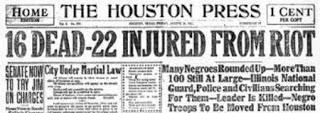
My main sources were three articles that I found online: Robert V. Haynes, "The Houston Mutiny and Riot of 1917" (Southwestern Historical Quarterly, 1973; online here); C. Calvin Smith, "The Houston Riot of 1917: Revisited" (Houston Review, 1991; online here); and Major Willard S. Squire's thesis, "The 24th Infantry Regiment and the Racial Debate in the US Army" (1997; online here). Haynes also wrote a full-length book on the riot, A Night of Violence (1976), which I wasn't able to locate.
For general background on black soldiers in the WWI era, see also: Garna L. Christian's Black Soldiers in Jim Crow Texas, 1899-1917 (1991), which includes a brief account of the riot; Cameron McWhirter, Red Summer: The Summer of 1919 and the Awakening of Black America (2011); and Richard Slotkin, Lost Battalions: The Great War and the Crisis of American Nationality (2005).
Other articles on World War I and the Age of Wilson:
- The American Polar Bears Meet the Bolsheviks
- The American Protective League and the War on Slackers, 1917-1919
- The Eastern Front, 1914-1917 (1975, Norman Stone)
- General Graves and the Siberian Shuffle
- The Guns of August (1962, Barbara W. Tuchman)
- The Hun's Shadow in America, 1917-1918
- Ring of Steel: Germany and Austria-Hungary in World War I (2014, Alexander Watson)
- The Siege (1970, Russell Braddon)
- Somerset County's Men of Iron in the Great War

